We're a family dental practice focusing on general dentistry. We see patients of all ages and ethnicities.
Smile Gallery
Veneers
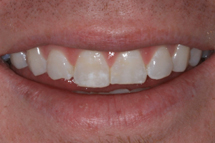
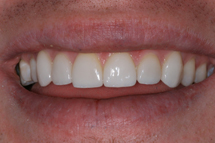
Crown Lengthening
This is a case of crown lengthening and new anterior or the 2 front teeth crowns
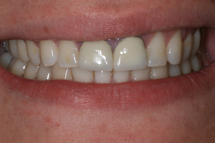
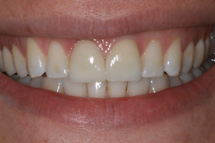
Implants
This is a case of implants due to periodontal disease.
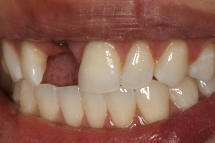
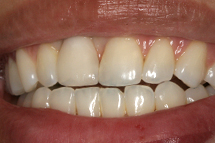
Crowns, Veneers and In-Office Whitening
This is a case of a patient how had chipped front teeth and wanted a (more) permanent solution and whiter teeth.
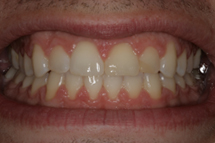
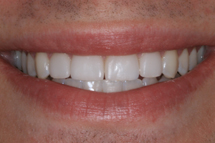
Services
Bonding & White Fillings
A bonding is a composite resin that is used as an alternative to amalgams and veneers. This is an excellent cosmetic option for those patients who do not want the look of silver in their mouths and do not want the expense associated with veneers. Bonding can be used on teeth that are decayed, cracked, or stained.
Procedure
The bonding procedure is usually completed in one visit. The first step is to remove the decayed or unsightly portion of the tooth. The tooth is then etched with a liquid or gel and a bonding agent is then applied. This will allow the composite resin to be placed in the prepared tooth. The resin is then trimmed and polished, leaving you with a beautifully sculpted, natural-looking restoration.
Bonding Durability
Although composite resins are cosmetically pleasing and easily placed, their durability is not as strong as other types of restorations. These resins typically last from 4-7 years before they may begin to chip and wear. When this happens, the restoration will need to be replaced.
Bridges
A bridge is one of the few options that you have when deciding how to deal with a missing tooth or teeth. The replacement of these missing teeth is necessary in order to maintain the proper mouth functions. Tooth loss can affect the way you eat, speak, and the alignment of other teeth in your mouth.
Types of Bridges
A bridge, by definition, is a link or connection between two permanent structures. A dental bridge is very similar in that it attaches the restorative teeth (bridge) to the natural teeth on either side of the gap. This bridge acts as your new teeth, closing the gap and restoring your smile. Bridges are often constructed of gold or metal foundations with porcelain fused to the foundation. This ensures that the bridge will support the normal functions of the mouth.
There are three main types of bridges:
- Traditional bridges involve creating a crown for the tooth or implant on either side of the missing tooth, with a pontic in between. Traditional bridges are the most common type of bridge and are made of either porcelain fused to metal or ceramics.
- Cantilever bridges are used when there are adjacent teeth on only one side of the missing tooth or teeth.
- Maryland bonded bridges (also called a resin-bonded bridge or a Maryland bridge) are made of porcelain teeth and gums supported by a metal framework. Metal wings on each side of the bridge are bonded to your existing teeth.
Procedure
The procedure begins with preparation of the natural teeth, or abutments. We will shape the abutment teeth so that the ends of the bridge will fit comfortably on each one. The next step is to take an impression of the area. This impression will be sent to our lab where your new restoration will be crafted. While this new tooth is created, we will provide you with a temporary restoration. Our temporary restorations will resemble your natural teeth so that you can continue with your daily life without worrying about a missing or unattractive tooth.
During your second visit to the office, we will proceed with the placement of your final restoration. This bridge will be fitted comfortably into the mouth. We will make every effort to ensure that the new bridge feels exactly like your natural teeth. The final step in the process is to cement the bridge into your mouth, leaving you with a beautifully restored smile.
Whitening/Bleaching
Over time our teeth tend to become discolored or stained. Whether this is from smoking, coffee, or any other foods, a beautiful smile could be closer than you think. We offer a safe, inexpensive solution to an unsightly smile. Whitening your teeth is a very simple procedure that can be completed in relatively short period of time.
Procedure
The first step in the whitening process is impressions. We will take full impressions of your upper and lower teeth. These impressions will be made into custom bleaching trays. The trays will fit onto your teeth perfectly so there is a small possibility of gum damage from the bleaching solution.
The second step is to place the bleaching solution in the trays and wear them for a few hours a day. Within 7-10 days, you will see a significant improvement in the color of your teeth. Your smile will look brighter and younger. We will take before and after photos so that you will be able to compare the amazing transformation.
Bleaching only works on natural teeth and may not be effective in all cases. We will inform you as to the potential whitening for your specific situation.
Crowns
As we get a little older, our teeth begin to change and are prone to decay. There are many possible reasons for this change in your smile. These reasons can include bruxism (teeth grinding), general decay, cracked fillings, root canals, and many others. If your tooth is beyond repair with a filling material, we may recommend that the best viable option to save the tooth is a full crown. The reasons for this type of restoration in a badly damaged tooth are durability, cosmetic appearance, and overall support of the chewing function.
Types of Crowns
If we decide that you are in need of a full crown, there are a few different options for the repair of your tooth. These options include a full porcelain crown, porcelain fused to metal or gold crown, or a full gold crown. We will make the determination as to which of these options is the most appropriate for your situation. You can be comfortable in knowing that your new tooth will be virtually unnoticeable and will flawlessly complement the rest of your smile.
Procedure
When we have decided to go ahead with a full crown restoration, we will set aside 2-3 appointments for the entire process. Although the majority of crowns are completed in two visits, there is sometimes a need for a third visit to ensure a proper fit.
The procedure begins with the removal of all decay in the tooth. Once we have removed the decay, we will take an impression of the tooth. This impression will be sent to our lab where your new restoration will be crafted. While this new tooth is created, we will provide you with a temporary restoration. Our temporary restorations will resemble your natural teeth so that you can continue with your daily life without worrying about a missing or incompatible tooth.
During your second visit to the office, we will proceed with the placement of your final restoration. This crown will be fitted comfortably into the mouth. We will make every effort to ensure that the new tooth feels exactly like one of your natural teeth. The final step in the process is to cement the crown into your mouth, leaving you with a beautifully restored smile.
Dental Hygiene & Periodontal Health
In addition to the meticulous cleaning, polishing, and examination of your teeth, we also take the time to help our patients develop proper oral hygiene habits at home. We will evaluate your hygiene techniques and make adjustments to your routine where needed. Our doctors and hygienists will also make suggestions for preventative measures such as dental sealants or night guards to protect against bruxism & TMJ.
If we feel that you are suffering from gingivitis or more severe gum disease, we may recommend a root scaling or planing. These measures can be instrumental in preventing bone loss and helping you to keep your natural teeth.
Oral Cancer Screenings
During a dental exam, the doctor will check your neck and oral tissues for lumps, red or white patches or recurring sore areas.
Screening for early changes in the oral tissue can help detect cancer at a stage when it can be more successfully treated.
Smoking, especially combined with heavy alcohol consumption (30 drinks a week or more), is the primary risk factor for oral cancer. In fact, this combination is estimated to be the most likely trigger in about 75 percent of oral cancers diagnosed in this country. Other lifestyle and environmental factors also may increase your risk of developing oral cancer.
Scaling & Root Planing
Scaling and root planing is a non-surgical procedure in which the periodontist removes plaque and tartar from below the gum line. Root surfaces are cleaned and smoothed with specially designed instruments. It is important to remove the plaque and tartar from the pockets, because aside from the bacterial toxins that irritate the gums, plaque and the rough surfaces of tartar make it easier for bacteria to gain a foothold.
Veneers
Porcelain veneers are extremely thin casings of ceramic that are bonded to the front of the patients’ tooth to create a new smile. Porcelain veneers are placed over the front of teeth that appear too small or large, slightly discolored, or simply are not cosmetically pleasing to the patient. For many patients, teeth may have chipped, become discolored, or are slightly crooked. For the majority of these patients, porcelain veneers can prove to be the perfect solution.
When placing porcelain veneers, we pay close attention to the patients surrounding teeth and design each veneer to complement the overall smile. The result is a beautiful, attractive new smile.
If cared for properly, your veneers will last you a long time. We ensure that your new veneers are constructed of the most durable porcelain materials available.
Procedure
The procedure begins with the preparation of the tooth. This entails removing the discolored or unsightly portion of the tooth and meticulously shaping the tooth in preparation for the new veneer. Once we have shaped the tooth, we will take an impression. This impression will be sent to our lab where your new restoration will be crafted. While the new veneers are created, we will provide you with a temporary restoration. Our temporary restorations will resemble your natural teeth so that you can continue with your daily life without worrying about a missing or incompatible tooth.
During your second visit to the office, we will proceed with the placement of your final restoration. The veneers will be fitted comfortably into the mouth. We will make every effort to ensure that the new tooth feels exactly like one of your natural teeth. The final step in the process will be to bond the new veneers into your mouth, leaving you with a beautifully restored smile.
Dental Implants
Dental implants are becoming more popular in today’s dental society for a number of reasons. Implants are utilized to offer patients a foundation for new restorative teeth where natural teeth are missing or have been extracted. The implant offers the patient the opportunity to regain normal function of the tooth without being forced to resort to a bridge or a denture.
Benefits
- The implant will bond with the existing bone
- The new implant will support your teeth firmly and safely
- Your new implants are aesthetically pleasing
- You will no longer have pain during talking or eating
- The dental implant will prevent progressive bone atrophy
Procedure
The tooth structure has two main sections, the root and the crown. The root is the section of the tooth that is below the gumline. A dental implant acts as the restorative for this section of the tooth. The metal implant acts as an anchor in the jawbone. The first step of the procedure is surgical placement of the implant. Under regular dental anesthetic, the gum tissue is opened and the dentist places the implant into the jawbone. When this is achieved, the tissue is then sutured closed. There is not often significant discomfort with this procedure. This process can take from 1-3 hours depending on the number of implants being placed.
This implant will be left untreated for a period of 3-6 months. During this time, the bone will grow around the implant in a process called osseointegration. A removable crown may be utilized during this time period to allow for chewing and to preserve the cosmetic appearance..
The next step in the process is to attach an abutment to the tooth. This is achieved by exposing the top of the implant and placing the abutment. This is the part of the implant that will support the final crown.
Finally, an impression is taken of the implant and a final restoration is crafted. This restoration will be comfortable and cosmetically pleasing. Your completed implant will be fully functional, allowing you to resume normal activities.
Dentures
What are dentures?
Dentures are replacements for missing teeth that can be taken out and put back into your mouth. While dentures take some getting used to, and will never feel exactly the same as one's natural teeth, today's dentures are natural looking and more comfortable than ever.
There are two main types of dentures: full and partial. Your dentist will help you choose the type of denture that's best for you based on whether some or all of your teeth are going to be replaced and the cost involved.
How long do dentures last?
Over a period of time, your denture will need to be relined, remade, or rebased due to normal wear. Rebasing means making a new base while keeping the existing denture teeth. Also, as you age, your mouth naturally changes. These changes cause your dentures to loosen, making chewing difficult and irritating your gums. At a minimum, you should see your dentist annually for a checkup.
How long before I get used to my dentures?
New dentures may feel awkward or uncomfortable for the first few weeks or even months. Eating and speaking with dentures might take a little practice. A bulky or loose feeling is not uncommon, while the muscles of your cheeks and tongue learn to hold your dentures in place. Excessive saliva flow, a feeling that the tongue does not have adequate room, and minor irritation or soreness are also not unusual. If you experience irritation, see your dentist.
How do dentures work?
With full dentures, a flesh-colored acrylic base fits over your gums. The base of the upper denture covers the palate (the roof of your mouth), while that of the lower denture is shaped like a horseshoe to accommodate your tongue.
Dentures are custom-made in a dental laboratory from impressions taken of your mouth. Your dentist will determine which of the three types of dentures described below is best for you.
Conventional Full Denture
A conventional full denture is placed in your mouth after any remaining teeth are removed and tissues have healed. Healing may take several months, during which time you are without teeth.
Immediate Full Denture
An immediate full denture is inserted immediately after the remaining teeth are removed. (Your dentist takes measurements and makes models of your jaw during a prior visit.) While immediate dentures offer the benefit of never having to be without your teeth, they must be relined several months after being inserted. The reason is that the bone supporting the teeth reshapes as it heals, causing the denture to become loose.
Partial Denture
A partial denture rests on a metal framework that attaches to your natural teeth. Sometimes crowns are placed on some of your natural teeth and serve as anchors for the denture. Partial dentures offer a removable alternative to bridges.
Caring for your dentures:
- When handling your dentures, stand over a folded towel or basin of water. Dentures are delicate and may break if dropped.
- Don't let your dentures dry out. Place them in a denture cleanser soaking solution or in plain water when you're not wearing them. Never use hot water, which can cause them to warp.
- Brushing your dentures daily will remove food deposits and plaque, and help prevent them from becoming stained. An ultrasonic cleaner may be used to care for your dentures, but it does not replace a thorough daily brushing.
- Brush your gums, tongue and palate every morning with a soft-bristled brush before you insert your dentures. This stimulates circulation in your tissues and helps remove plaque.
- See your dentist if your dentures break, chip, crack or become loose. Don't be tempted to adjust them yourself, this can damage them beyond repair.



